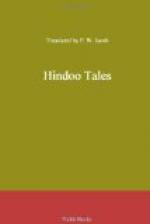TRANSLATOR’S PREFACE.
Adventures of Somadatta.
Adventures of Pushpodbhava.
Marriage of Avantisundari.
Further adventures of Rajavahana.
Adventures of Apaharavarma.
Adventures of Upaharavarma.
Adventures of Arthapala.
Adventures of Pramati.
Adventures of Mitragupta.
Adventures of Mantragupta.
Adventures of Visruta.
Literal translations.
Proper names occurring in the tales.
There was formerly, in the most fertile part of India, a city called Pushpapuri, the capital of Magadha, magnificent as a mine of jewels, abounding in every kind of wealth, surpassing all other cities in splendour and prosperity.
The sovereign of this city and country was Rajahansa, whose armies were formidable with countless elephants and horses, whose glory was unsullied as the moon in a cloudless sky, or the plumage of the swan, and whose fame was sung even by celestial minstrels. Though a terror to his enemies, he was beloved by all his subjects, and especially by the learned and pious brahmans, who were continually employed in prayers and sacrifices to the gods, for the welfare of the king and his people.
The queen Vasumati was worthy of such a husband. She was of high birth and of a sweet temper, and so great was her beauty that it seemed as if the god of love had formed her for his own special delight, by uniting in her single person everything that is most beautiful in the world.
Among the king’s counsellors were three appointed to the highest offices of state, men of great probity and intelligence, who had been long in his father’s service and enjoyed his entire confidence. Their names were, Dharmapala, Padmodbhava, and Sitavarma.
The first of these had three sons, Sumantra, Sumittra, and Kamapala; the second, two, Susruta and Ratnodbhava; and the last had also two, Sumati and Satyavarma.
Of these sons the last-mentioned renounced worldly cares and employments, devoted himself to religious meditation, and leaving home as a pilgrim, travelled into many countries in order to visit the holy places which they contained.
Kamapala was of an opposite character; he thought only of present pleasure, frequented the company of gamblers and harlots, and roamed about the world seeking amusement and dissipation.
Ratnodbhava became a merchant, and in the way of traffic made many long journeys by land and sea. The other sons, after their fathers’ death, succeeded to their offices, according to the custom of the country. When Rajahansa had reigned some years, war broke out between him and the king of the adjoining country of Malwa, the haughty and ambitious Manasara, whom he marched to encounter with a numerous army, making the earth tremble with the tread of his elephants, and disturbing even the dwellers in the sky with the clang of kettledrums louder than the roar of the stormy ocean.




